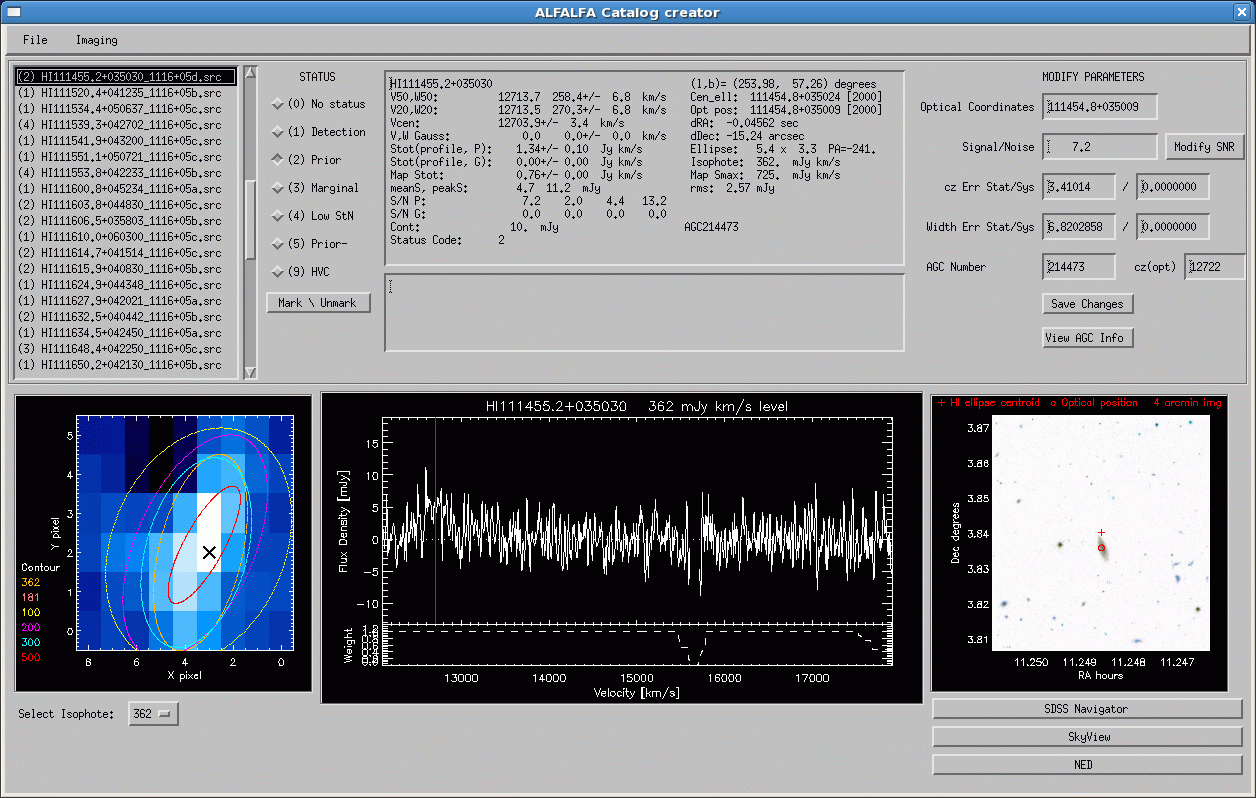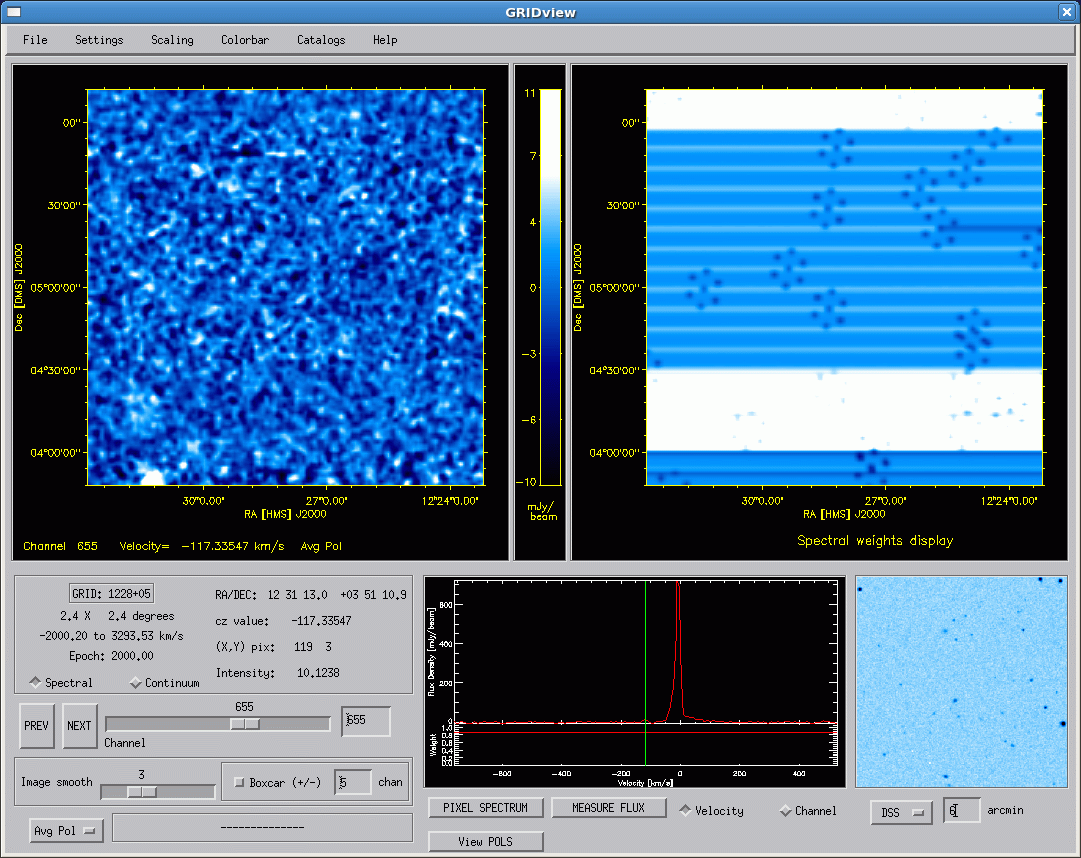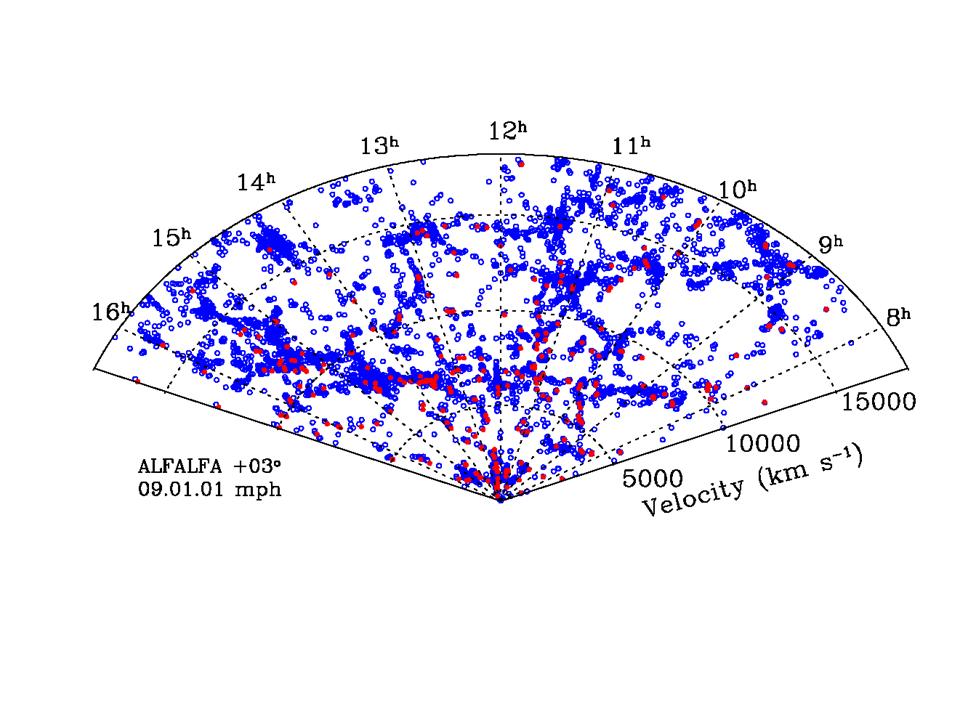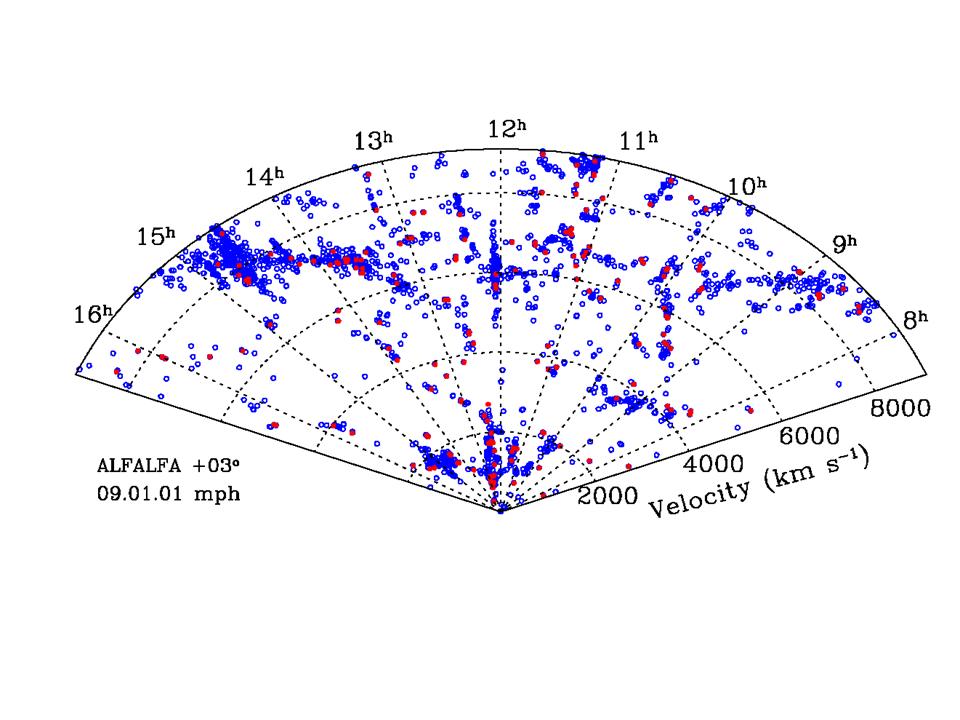UAT12.01 Scavenger Hunt #3: Introduction to ALFALFA grids and catalog data
This scavenger hunt will provide an introduction to the ALFALFA catalogs, deriving galaxy properties from observational data and investigating the large scale structure. 3.0 ALFALFA grids and catalogs| Here is a small subset of the currently available ALFALFA catalog. Additionally, here are some screen shots of LOVEDATA screens of two objects contained in the subcatalog. Refer to this subcatalog and these figures in answering the following questions. Note: We are interested in sources that will be in the +31 and +33 degree grids, but of course, since we are still observing that part of the sky, the grids don't yet exist. These sources all lie in the southernmost part of the +5 degree grids. a. The HI profile is often two-horned. Sometimes it has a Gaussian shape. Under what circumstances would be expect to see a Gaussian shape, rather than the characteristic two horns? b. How is the profile width, W50, measured on a two-horned profile? c. What is meant by "rms"? d. What is meant by "SN"? e. In the GRIDVIEW displays, what causes the patterns of dark blue dots in the right hand panel? e. What is the HI source name of AGC214473? f. Why isn't the "position" in the HI source name the same as the "ellipse center" position? g. What grid contains AGC 214473? h. What is the HI mass of AGC 214473? i. What is the heliocentric velocity of HI123117.1+035049? j. What is unusual about AGC 227983? k. There are 3 HI emission features in the GALCAT display of the spectrum of AGC 227983. What do they arise from? l. In what favorite ALFALFA team movie does the physicist hero say: "You know, there's such a very thin dividing line between 'inspiration' and 'obsession', that sometimes it's very hard to decide which side we're really on!" |  A214473 GRIDVIEW  A214473 GALCAT  A227983 GRIDVIEW  A227983 GALCAT |
3.1 Identifying the most probable optical counterpart. One of the most important extra contributions of ALFALFA and an integral part of the source extraction process is the identification of the most probable optical counterpart to each HI source -- where such exists. Since ALFALFA galaxies don't care that we are observing them only in the HI 21 cm line, we need to know if they have a stellar component. And since ALFALFA data cubes have a resolution of about 4 arcminutes, we need to know when the detection is clearly associated with a galaxy -- or not!. If a source does not have an optical counterpart and is not a high velocity cloud, then it is a candidate OH megamaser or a candidate "dark galaxy".... or an evil spurious detection (aaarrgg!) The practice of identifying the most probable optical counterpart adds considerably to the effort of construction ALFALFA source catalogs. It is easier said than done. It requires astronomer intelligence, which is unfortunately why we cannot train our cats to produce catalogs (otherwise, we surely would have!). a. Upon what factors does the ability to centroid a source observed with any telescope depend? b. On average, how accurately are we able to measure the position of the centroid of an ALFALFA detection? C. The table below presents five ALFALFA detections; given are parameters extracted from the HI measurement. Find the most probably optical counterpart. Use the tools you have learned about before to examine useful optical databases.
| HI centroid (J2000) | HI flux | cz | W50 | SN | OC coordinates | Your comments |
|---|---|---|---|---|---|---|
| 014106.4+271903 | 0.69 | 274 | 26 | 13.1 | ||
| 095452.2+142907 | 0.61 | 12557 | 117 | 7.3 | ||
| 123120.9+050402 | 0.65 | 9873 | 151 | 4.9 | ||
| 152240.3+055017 | 0.44 | 1796 | 24 | 9.0 | ||
| 160745.2+272220 | 0.89 | 7602 | 84 | 10.9 |
3.2 Exploring the SDSS To estimate the total dynamical mass of a galaxy, we need to make use of optical and HI line data. Let's explore the object mentioned above AGC 214473. For starters, let's find the image and some basic SDSS data on this galaxy. a. Describe the appearance of the galaxy in the SDSS image b. What is the rest wavelength of the strongest emission line seen in its spectrum? c. How much brighter is the galaxy in the r-band than in the u-band? d. In a very famous movie, what would be the (r-i) color index of Mary Kate Danaher's hair? e. Then go to the SQL for DR7 amd run the SQL query below:
SELECT
p.ra, p.dec,s.z,s.zerr,p.petroR90_r,p.expAB_r,
p.petroMag_u,p.petroMag_r,
p.objID
FROM PhotoObj p, SpecObj s, SpecLine l
WHERE
p.SpecObjID = s.SpecObjID AND
p.SpecObjID = l.specobjID AND
s.specClass=2 AND
l.lineID = dbo.fSpecLineNames('Ha_6565') AND
p.objID=588010358007595145
|
3.3 Distances: Hubble's Law doesn't always work! a. What is the redshift of M31, the Andromeda galaxy? b. What is the distance to M31? Give you answer in both light years and Mpc. c. UGC 7470 = IC 3258 is detected by ALFALFA with a heliocentric velocity of -430 km/s. What is its probable distance? d. What is the motion of the Sun with respect to the frame of rest of the Cosmic Microwave Background radiation? e. What character in a famous film said: "Well, the universe is everything, and if it's expanding, some day it will break apart and that will be the end of everything."
3.4 Galaxies cluster!
|
Here are two diagrams of the current AGC
redshift distribution in the sky area
that will be contained in the future ALFALFA spring sky +03o grids.
The slices shown are bounded by 07h30m < R.A. < 16h30m
and +01.75o < Dec. < +04.25o.
The velocities here are heliocentric. Blue points illustrate the locations of galaxies of
known redshift; filled red circles mark ones with (current) HI data. ALFALFA will add
to both these diagrams. Refer to the diagrams in answering the following questions.
Note: since the ALFALFA results are not yet available, there aren't very many red points in these
diagrams! Next year, they will look much richer, especially the lower one. a. Identify the clusters in the distribution and find their matches in the NED b. Identify a filamentary structure. How long (in Mpc) is it (assuming it is real)? c. In what movie is Clark Gable's character determined to return to the Bungo Straights? d. Estimate the size (in Mpc) of the apparent void centered at R.A. ~9h20m, cz ~ 14000 km/s. e. In what movie is it said "...[The] rules of engagement are written for your safety and for that of your team. They are not flexible... Either obey them or you are history. Is that clear?" |
 Cone diagram of the full ALFALFA velocity range  Cone diagram of the inner 9000 kms/s |
This page created by and for the members of the ALFALFA Survey Undergraduate team Last modified: Mon Jan 9 16:17:19 EST 2012 by Martha
